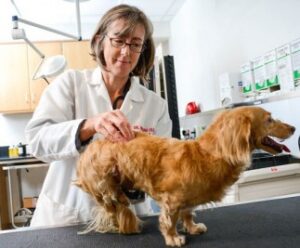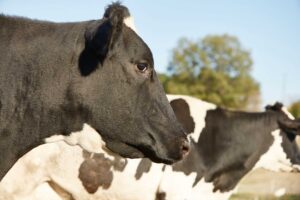NC State Veterinary Medicine Research Roundup, November 2020

A look at some of the latest published research from the NC State College of Veterinary Medicine.
Canine Cognitive Development
A survey of the first two years of life in dogs contributes to the understanding about changes in dog condition across early development, as well as the origins and development stability of individual differences.
For the study, co-authored by Margaret Gruen and published by Animal Cognition, researchers studied 8-to-10-week-old puppies and then retested the same group on the same tasks at about 21 months of age. Tasks were designed to measure diverse aspects of cognition, ranging from inhibitory control and memory to vision, hearing and smell.
Task performance almost universally improved with age, and individual differences in cognition were both early emerging and enduring, including social attention to humans, use of human communicative signals and odor discrimination.
Researchers also found that young adult canine performance on many cognitive tasks could be predicted from a set of cognitive measures collected in early development.
Read the study here.
Companion Animals and Acute Paralysis

A retrospective study of NC State Veterinary Hospital emergency room records finds the most common causes of acute paralysis in dogs and cats seen at the hospital over a five-year period were intervertebral disc disease (IVDD) and aortic thromboembolism (ATE).
Researchers found that IVDD was the most common cause in dogs (72% of cases), followed by vascular disease. Dachshunds and Labrador retrievers were the most common breeds impacted. In cats, ATE was the most common diagnosis (61% of cases), followed by IVDD (11%).
Acute paralysis is commonly seen in small animal emergency clinics, but the prevalence of contributing factors to its development has not been reported. Such knowledge aids diagnoses and clinical trial design.
The authors of the study, published in Vet Record, are Natasha Olby, Alex Lynch, Alexandra Stachel and Graham Rossi. Read the study here.
Development of Organ Asymmetry
A new study sheds light on the mechanisms shaping individual organ asymmetries, information that may provide insight into the development of birth defects and the overall nature of organ development.
The study, authored by Nanette Nascone-Yoder, Brent Wyatt and Julia Grzymkowski, details the asymmetric morphogenesis of the stomach and intestine, and also reviews the development of gut-derived/associated organs, including the liver and lung, focusing on tissue-level changes.
Organ development of left-right asymmetric shapes and positions are crucial for normal function. Deviations from that process are associated with multiple severe birth defects.
Read the study, published in Development, here.
Effectiveness of Electrothermal Therapy
The new cancer treatment approach of electrothermal therapy (ETT) is a viable way to target tumors and may enable treatment of complex tumor geometries, according to new research co-authored by Callie Fogle.
The study, published in Computers in Biology and Medicine, examines the potential of pulsed electric field treatments delivered in conjunction with precise temperature control algorithms using a liver model.
Researchers found the flexibility of ETT temperature control yields a malleable intervention, giving clinicians robust control over surgical ablation, treatment time and safety.
Read the study here.
Equine Respiratory Disease 
The pathogen Streptococcus zooepidemicus may play a role in clinical respiratory disease of working horses in Ethiopia, according to research co-authored by Andy Stringer and published in the Equine Veterinary Journal.
A review of 108 cases found horses often had underlying lower airway pathology and were significantly more likely to have S. zooepidemicus detected. Risk factors included completion of strenuous work, drinking stagnant water and behind houses on a cobbled floor. Young and old horses had increased odds of respiratory disease.
Respiratory disease is a major cause of time off work and poor performance for horses and is a priority health concern for owners in Ethiopia.
Read the study here.
Feline Heart Health Data
A study with authors including Yu Ueda and Ashley Walker establishes reference intervals for echocardiographic and radiographic quantification of heart size in healthy kittens.
The establishment of reference intervals for thoracic radiograph assessment, echocardiography and cardiac biomarkers in kittens fills a critical gap in veterinary literature and prevents misinterpretation of cardiomegaly in kittens.
Read the study, published in the Journal of Feline Medical Surgery, here.
Impact of Mastitis on Milk Production 
A study co-authored by Kevin Anderson evaluates the effects of chronic subclinical mastitis (CSM) on milk production and component yields in dairy cows.
The research, published by The Veterinary Journal, found that milk loss and composition alteration depended on the pathogen causing mastitis, that chronic mammary quarters produced less milk than healthy quarters and infection with environmental streptococci and Staph. aureus reduced milk production. Minor pathogens causing CSM, including non-aureus staphylococci and Corynebacterium spp., had no effect on milk yield.
CSM in cows is inflammation of the udder often caused by bacterial infections. Severe cases can be life-threatening.
Read the study here.
~Jordan Bartel/NC State Veterinary Medicine


